Protest chaos has caused heavy losses for companies and universities
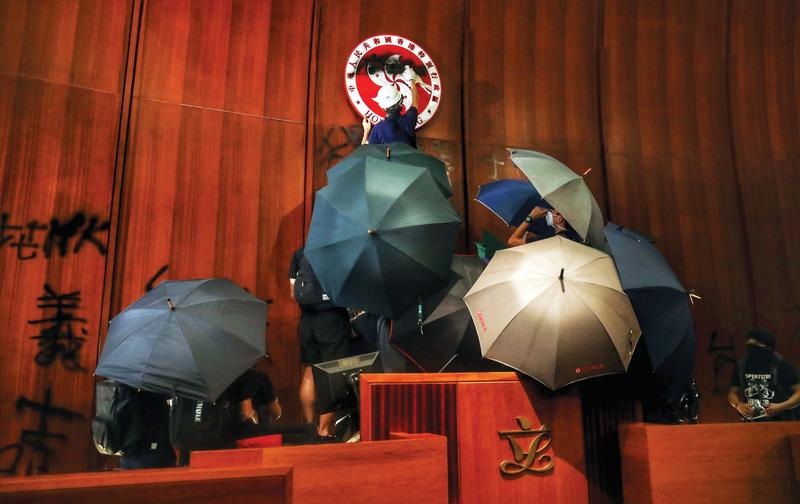 Protesters who stormed the Legislative Council complex deface the national emblem of the Hong Kong Special Administrative Region on July 1. (PHOTO / CHINA DAILY)
Protesters who stormed the Legislative Council complex deface the national emblem of the Hong Kong Special Administrative Region on July 1. (PHOTO / CHINA DAILY)
Amid the protest violence and chaos that has roiled Hong Kong for more than seven months, even bystanders who seem furthest from the political storm have not escaped the effects.
On June 7, rioters threw the first gasoline bomb at a police vehicle, marking the beginning of the violent protests. There have been over 1,200 public demonstrations, processions and public meetings, according to the Hong Kong Special Administrative Region government. Many had ended in violent and illegal confrontations, including reckless blocking of roadways, the throwing of bricks and gasoline bombs, vandalism, arson, setting individual stores ablaze, as well as damage to Mass Transit Railway and light rail facilities.
The black-clad rioters and their escalating violence have affected almost every aspect of people’s daily lives. People’s work routines and studies often have been severely disrupted.
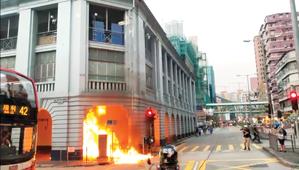 Sham Shui Po Police Station, a Grade II historic building built in 1925, is set on fire on Oct 20. (PHOTO / CHINA DAILY)
Sham Shui Po Police Station, a Grade II historic building built in 1925, is set on fire on Oct 20. (PHOTO / CHINA DAILY)
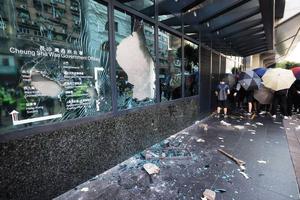 Radicals take cover under umbrellas after smashing the windows of government offices in the Cheung Sha Wan district on Oct 1. (PHOTO / CHINA DAILY)
Radicals take cover under umbrellas after smashing the windows of government offices in the Cheung Sha Wan district on Oct 1. (PHOTO / CHINA DAILY)
 A blaze erupts at the entrance of the High Court building after rioters firebombed the courthouse on Dec 8. The Court of Final Appeal Building was also targeted by arsonists. (PHOTO / CHINA DAILY)
A blaze erupts at the entrance of the High Court building after rioters firebombed the courthouse on Dec 8. The Court of Final Appeal Building was also targeted by arsonists. (PHOTO / CHINA DAILY)
At times, the city’s traffic has been brought to a standstill, the world-renowned metro system run by MTR Corp has been paralyzed, and even Hong Kong International Airport was once forced to shut down operations. Traffic chaos has even led to citywide class cancellations in schools.
Chinese mainland-linked companies, banks and shops in Hong Kong have been targets for attack, including snacks chain Best Mart 360, consumer electronics company Xiaomi, Chung Hwa Book Company, Chinese medicine company Beijing Tong Ren Tang, and banks like Bank of China and China Construction Bank. In an interview with Bloomberg TV on Nov 11, Lin Tsz Fung, chairman of Best Mart 360 Holdings, said more than 70 of its 102 stores had been vandalized, in over 180 instances.
Foreign brands like American coffeehouse chain Starbucks, Japanese fast-food chain Yoshinoya and restaurant chain Genki Sushi also fell victim as the local franchisee is Hong Kong catering giant Maxim’s Group. Annie Wu Suk-ching, daughter of the group’s founder, enraged rioters after she spoke against the anti-government protests at the United Nations Human Rights Council in September. The attacks have not stopped even after the company said Wu does not have a management role.

The glass doors of an Adidas store in the Mong Kok district were also smashed by protesters because the sports brand’s spokesperson Chinese actress Liu Yifei expressed support for the Hong Kong police.
Many small businesses, mainly restaurants, in different districts were attacked by rioters on suspicion of their stance in the protests. Those who voiced support for the government or are said to have a mainland Chinese background are categorized as “blue” shops and regarded as foes by protesters.
Hong Kong is a recognized financial hub, but on Nov 13, protest chaos and traffic disruption led to the full-day closure of 250 bank branches — the most in the city’s history except during severe typhoons, and representing about 19 percent of all 1,300 branches in the city, according to local media.
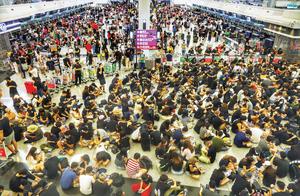 Protesters staging a mass sit-in disrupt operations at Hong Kong International Airport on Aug 13. (PHOTO / CHINA DAILY)
Protesters staging a mass sit-in disrupt operations at Hong Kong International Airport on Aug 13. (PHOTO / CHINA DAILY)
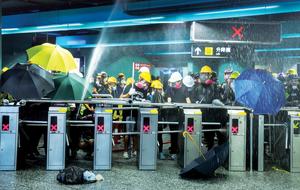 Rioters use steel barricades to form a defensive line inside the Quarry Bay MTR station, as they face off with riot police on Aug 11. (PHOTO / CHINA DAILY)
Rioters use steel barricades to form a defensive line inside the Quarry Bay MTR station, as they face off with riot police on Aug 11. (PHOTO / CHINA DAILY)
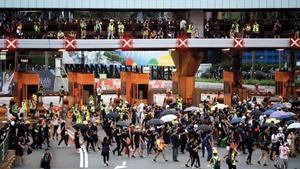 Black-clad protesters disrupt traffic at the Cross-Harbour Tunnel after occupying the toll plaza in the Hung Hom district on Aug 3. (PHOTO / CHINA DAILY)
Black-clad protesters disrupt traffic at the Cross-Harbour Tunnel after occupying the toll plaza in the Hung Hom district on Aug 3. (PHOTO / CHINA DAILY)
The violent protests since June have battered nearly all sectors of the Hong Kong economy, with retail, tourism and transportation among the hardest-hit sectors.
The value of total retail sales in October was estimated to have fallen 24.3 percent compared with the same month a year earlier, government data showed.
The number of tourists to Hong Kong plunged 56 percent year-on-year to 2.65 million in November, according to the Hong Kong Tourism Board.
About 740 sets of traffic lights were broken, more than 52,000 meters of roadside railing pillaged, and 21,000 square meters of paving blocks ripped out, said the Hong Kong government in December. Chief Executive Carrie Lam Cheng Yuet-ngor said the amount of parts used for replacing lamps and controllers would be adequate for 10 years under normal situations.
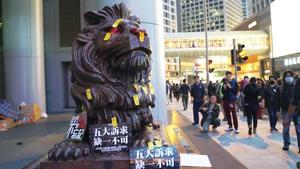 A bronze lion statue outside the HSBC headquarters in the Central district is vandalized during protests on Jan 1, 2020. (PHOTO / CHINA DAILY)
A bronze lion statue outside the HSBC headquarters in the Central district is vandalized during protests on Jan 1, 2020. (PHOTO / CHINA DAILY)
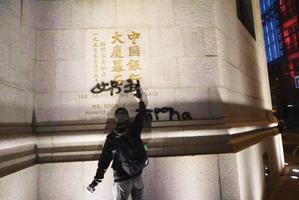 A black-clad protester spray-paints a wall of the Bank of China Tower in Central on Dec 8. (PHOTO / CHINA DAILY)
A black-clad protester spray-paints a wall of the Bank of China Tower in Central on Dec 8. (PHOTO / CHINA DAILY)
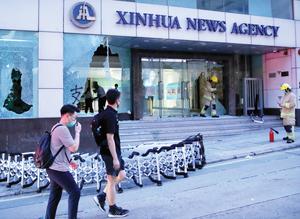 A passer-by views damage done to Xinhua News Agency’s Asia-Pacific Regional Bureau in the Wan Chai district on Nov 2. Rioters smashed windows, set fires and spray-painted insulting messages on the building. (KIN CHEUNG / AP)
A passer-by views damage done to Xinhua News Agency’s Asia-Pacific Regional Bureau in the Wan Chai district on Nov 2. Rioters smashed windows, set fires and spray-painted insulting messages on the building. (KIN CHEUNG / AP)
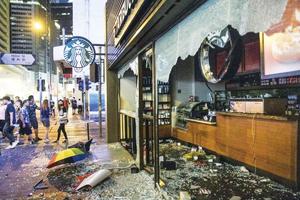 A Starbucks outlet in the Sheung Wan area is smashed up on Nov 2. (ANTHONY WALLACE / AFP)
A Starbucks outlet in the Sheung Wan area is smashed up on Nov 2. (ANTHONY WALLACE / AFP)
The repairs would cost HK$65 million (US$8.3 million), according to the Transport and Housing Bureau. From June to November, a total of 41 people were hurt in 20 accidents involving defective traffic signals.
The cost for repairing the Legislative Council building vandalized by protesters on July 1 has reached about HK$40 million.
Also, universities were turned into battlefields and “weapons factories” for criminals and rioters. Police said on Dec 4 that nearly 10,000 gasoline bombs had been seized from campuses across the city, including Chinese University of Hong Kong and the Hong Kong Polytechnic University.
Local media reported that the cost to repair campus facilities would reach HK$70 million for the Chinese University. The City University of Hong Kong announced that its repair costs would mount to a nine-digit figure.
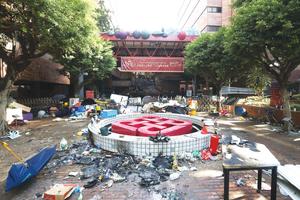 The campus of Hong Kong Polytechnic University is littered with waste on Nov 18 after radical students and protesters turned it into a stronghold in their standoff with police. (PHOTO / CHINA DAILY)
The campus of Hong Kong Polytechnic University is littered with waste on Nov 18 after radical students and protesters turned it into a stronghold in their standoff with police. (PHOTO / CHINA DAILY)
 Debris blocks an entrance to the Chinese University of Hong Kong campus on Nov 13. (PHOTO / CHINA DAILY)
Debris blocks an entrance to the Chinese University of Hong Kong campus on Nov 13. (PHOTO / CHINA DAILY)
In mid-November, the HKSAR government forecast that Hong Kong’s economy will have contracted 1.3 percent in 2019, marking the first annual GDP contraction since 2009 during the global financial crisis. The government confirmed the economy plunged into its first recession in a decade in the third quarter. The unemployment rate rose to 3.2 percent as at end-November, the highest level since 2017.
All in all, the months of violent protest have exacted a heavy toll on ordinary citizens yearning for peace and order.


